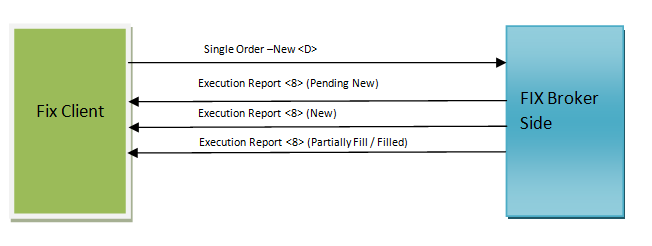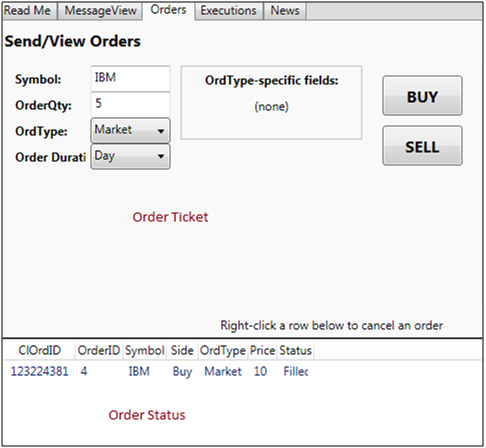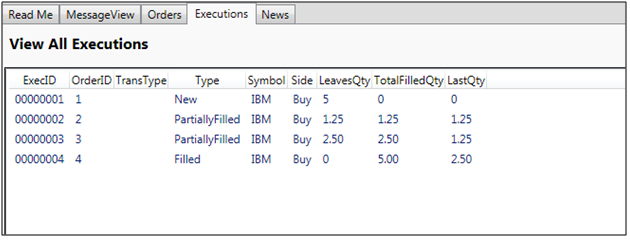Purpose
The purpose of this post is to walk-through implementation to “Place an Order on via FIX message channel”.
In my previous posts, I have shown basic implementation of FIX messages like Establish connection with broker/exchange Fix End points, Consume Market Feeds etc.
You can read my previous posts about topics mentioned above:
- Fix Message Implementation using QuickFix
- Consume Market feeds on FIX Protocol from Fix enabled broker/exchange using QuickFix/n
This post will cover following topics:
- Different types of Orders.
- Orders Validity
- Order workflow.
- Place Order
- What is Execution Report?
- Process Execution Report.
Order Types:
- Market Order: This is basic type of order; wherein, trader buy or sell at market price without specifying desired buy or sell price.
- Limit Order: It is an order to buy or sell at a specified price. A limit buy order can execute at specified buy price or lower. A limit sell order can execute at specified price or higher. In this order, trader has to specify price before placing an order.
- Stop Order: It is similar to market order which execute when specific price triggers. For example, if the market price is 150, a trader places a buy stop order with a price of 60, when price would move 160 or above, this order will become market order and execute at best available price. This type order can be used for Take-Profit and Stop-Loss.
- Stop Limit Order: This is a combination of stop order and limit order, like stop order, it is only processed if the market reaches a specific price, but it is executed limit order, therefore it will only get filled at the chosen or a better price. For example, if the current price is 150, a trader might place a buy stop limit order with a price of 160. If the market trades at 160 or above, this order will execute as limit order to get filled at 160. However, it might happen that this order may not fill if there is not depth available.
Detail description of each order types can be read on investopedia.
Order Validity
In addition to specify order types, trades can also specify validity of an order for how long particular order is valid. Order would be cancelled after expiry.
Traders can specify following validity of an order:
- Day: Order is only valid till end of the market session.
- GTC (Good till Cancel): Order is valid till trader manually cancels it. However, brokers might have max timeline to cancel orders automatically if order is beyond certain days, typically 30, 60 or 90 days.
- GTD (Good till Date): Order is valid till end of the market session of specified date mention in this order.
- IOC (Immediate or Cancel): Order should be partially/filled immediately while placing order; otherwise, it would be cancelled.
- FOK (Fill or Kill): Either order would be fully filled or cancelled. This type of order would not allow any partial fills.
FIX Order workflow
What is Execution Report?
It is FIX message which broker side sent in response to order request. Broker side relays status of an order, and there can be multiple Execution Reports for a single order. Execution reports can have following status and information:
Order Status
| Order Status | Description |
| Done for Day | Order did not fully or partially filled; no further executions are pending for the trading day. |
| Filled | Order completely filled; no remaining quantity. |
| Suspended | Order has been placed in suspended state at the request of the client. |
| Canceled | Canceled order with or without executions. |
| Expired | Order has been canceled in broker’s system due to order validity (Time In Force) instructions. |
| Partially Filled | Outstanding order with executions and remaining quantity. |
| Replaced | Replaced order with or without executions |
| New | Outstanding order with no executions |
| Rejected | Order has been rejected by broker. NOTE: An order can be rejected subsequent to order acknowledgment, i.e. an order can pass from New to Rejected status. |
| Pending New | Order has been received by brokers system but not yet accepted for execution. An execution message with this status will only be sent in response to a Status Request message. |
| Accepted | Order has been received and is being evaluated for pricing. |
Important Fields
| Field | Description |
| ClOrderId | Unique key of an order requested by client. |
| OrderId | Unique key generated by broker/exchange for an order. |
| ExecID | Unique key of each execution report message. |
| Account | Account number on which order was placed. |
| OrdType | Type of Order e.g. Market , Limit |
| Price | Ordered Price specified to buy or sell |
| Side | Side of an order (buy or Sell) |
| Symbol | Symbol name of instrument on which order placed. |
| SecurityId | InstrumentID |
| LastPx | Orderd executed on this price. |
| LastQty | Traded quantity in each fill |
| LeavesQty | Remaining Qty of an order. It is zero when order is fully filled. |
| CumQty | Total Traded Quantity |
Implementation
Technology/Tools Used:
- Examples are written in C#.
- Fix message parser Library: QuickFix/n
- Online Fix Log tool: http://FixHawk.Terebrum.com
- Basic Demo Application:
I have downloaded FIX UI Demo code from QuickFix/n Git hub location to save some time. This sample code already has connection and order routines. I will do further changes to show various use cases of order work flow with FIX 4.4 specification. I have also added FIXAcceptor component to process FIX messages locally.
Connect with FIX Acceptor
Click on connect button. Fix Initiator will send Logon message, which will be received by FIX acceptor and acknowledge it in reverse sending logon message.
Application is ready to place an order after connection is established.
Placing Order
Fix 4.4 supports “Single Order – New <D>” to place any single order by the client. You can find standard specification this message on any fix dictionary available online. However, message specification might differ from broker to broker.
You can see standard FIX messages/tags specification on FIXIMATE .
Create an object of “NewOrderSingle” class and set values to properties of class:
Code:
// hard-coded fields
QuickFix.Fields.HandlInst fHandlInst = new QuickFix.Fields.HandlInst(QuickFix.Fields.HandlInst.AUTOMATED_EXECUTION_ORDER_PRIVATE);
// from params
QuickFix.Fields.OrdType fOrdType = FixEnumTranslator.ToField(orderType);
QuickFix.Fields.Side fSide = FixEnumTranslator.ToField(side);
QuickFix.Fields.Symbol fSymbol = new QuickFix.Fields.Symbol(symbol);
QuickFix.Fields.TransactTime fTransactTime = new QuickFix.Fields.TransactTime(DateTime.Now);
QuickFix.Fields.ClOrdID fClOrdID = GenerateClOrdID();
QuickFix.FIX44.NewOrderSingle nos = new QuickFix.FIX44.NewOrderSingle(fClOrdID, fSymbol, fSide, fTransactTime, fOrdType);
nos.HandlInst = fHandlInst;
nos.OrderQty = new QuickFix.Fields.OrderQty(orderQty);
nos.TimeInForce = FixEnumTranslator.ToField(tif);
if (orderType == OrderType.Limit)
nos.Price = new QuickFix.Fields.Price(price);
Process Execution Report
public void HandleExecutionReport(QuickFix.FIX44.ExecutionReport msg)
{
string execId = msg.ExecID.Obj;
string execType = FixEnumTranslator.Translate(msg.ExecType); Trace.WriteLine("EVM: Handling ExecutionReport: " + execId + " / " + execType);
ExecutionRecord exRec = new ExecutionRecord( msg.ExecID.Obj,
msg.OrderID.Obj,
string.Empty,
execType,
msg.Symbol.Obj,
FixEnumTranslator.Translate(msg.Side));
exRec.LeavesQty = msg.LeavesQty.getValue();
exRec.TotalFilledQty = msg.CumQty.getValue();
exRec.LastQty = msg.LastQty.getValue();
}
FIX Acceptor
This is server side component which process messages from FIX clients and send response back to them.
Executor Class
This class is getting various methods callbacks once received FIX message from FIX Client.
public void OnMessage(QuickFix.FIX44.NewOrderSingle n, SessionID s)
This method will be called every time when “NewOrderSingle” message received.
I am simulating different status of an execution report. I have added 1 sec sleep time between each status change and can be clearly seen in UI.
public void OnMessage(QuickFix.FIX44.NewOrderSingle n, SessionID s)
{
Symbol symbol = n.Symbol;
Side side = n.Side;
OrdType ordType = n.OrdType;
OrderQty orderQty = n.OrderQty;
Price price = new Price(DEFAULT_MARKET_PRICE);
ClOrdID clOrdID = n.ClOrdID;
switch (ordType.getValue())
{
case OrdType.LIMIT:
price = n.Price;
if (price.Obj == 0)
throw new IncorrectTagValue(price.Tag);
break;
case OrdType.MARKET: break;
default: throw new IncorrectTagValue(ordType.Tag);
}
// Send Status New
SendExecution(s, OrdStatus.NEW, ExecType.NEW, n, n.OrderQty.getValue(), 0, 0, 0, 0);
Thread.Sleep(1000);
// Send Status Partially Filled
decimal filledQty = Math.Abs(Math.Round(n.OrderQty.getValue() / 4, 2));
decimal cumQty = filledQty;
SendExecution(s, OrdStatus.PARTIALLY_FILLED, ExecType.PARTIAL_FILL, n, filledQty, filledQty, price.getValue(), filledQty, price.getValue());
Thread.Sleep(1000);
// Send Status Partially Filled
filledQty = Math.Abs(Math.Round(n.OrderQty.getValue() / 4, 2));
cumQty += filledQty;
SendExecution(s, OrdStatus.PARTIALLY_FILLED, ExecType.PARTIAL_FILL, n, n.OrderQty.getValue() - cumQty, cumQty, price.getValue(), filledQty, price.getValue());
Thread.Sleep(1000);
// Send Status Fully Filled
filledQty = n.OrderQty.getValue() - cumQty;
cumQty += filledQty;
SendExecution(s, OrdStatus.FILLED, ExecType.FILL, n, 0, cumQty, price.getValue(), filledQty, price.getValue());
}
private void SendExecution(SessionID s, char ordStatus, char execType, QuickFix.FIX44.NewOrderSingle n, decimal leavesQty, decimal cumQty, decimal avgPx, decimal lastQty, decimal lastPrice)
{
QuickFix.FIX44.ExecutionReport exReport = new QuickFix.FIX44.ExecutionReport(
new OrderID(GenOrderID()),
new ExecID(GenExecID()),
new ExecType(execType),
new OrdStatus(ordStatus),
n.Symbol, //shouldn't be here?
n.Side,
new LeavesQty(leavesQty),
new CumQty(cumQty),
new AvgPx(avgPx));
exReport.ClOrdID = new ClOrdID(n.ClOrdID.getValue());
exReport.Set(new LastQty(lastQty));
exReport.Set(new LastPx(lastPrice));
if (n.IsSetAccount())
exReport.SetField(n.Account);
try
{
Session.SendToTarget(exReport, s);
}
catch (SessionNotFound ex)
{
Console.WriteLine("==session not found exception!==");
Console.WriteLine(ex.ToString());
}
catch (Exception ex)
{
Console.WriteLine(ex.ToString());
}
}
This post exhibits standard way of handling FIX messages; however, implementation can vary from broker to broker.
I hope, this post will give you good understanding of how order can be placed via FIX channel. I will cover order cancel and replace scenario in next post.
Source Code
Source code can be downloaded from github repository. Executable files are placed in separate folder.



